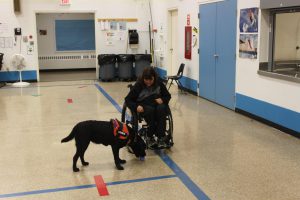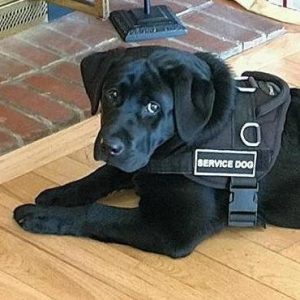Editor’s Note: As a single mom of a 7-year-old, Amy Sherwood was diagnosed with adrenal insufficiency and postural orthostatic tachycardia syndrome (POTS), a condition that often causes dizziness and loss of consciousness upon standing. When she returned home after a lengthy hospital stay, doctors insisted she use a wheelchair despite having fully functioning legs. Standing up was just too risky. That day, she began her journey as a person living with a disability and started figuring out new ways to do those mundane yet unavoidable daily tasks from her chair. Today, her son is grown and living on his own, so Sherwood has a new companion to help her with those day-to-day chores — a black Labrador named Dolly Pawton — who stars in her new book that teaches children about the life of a service dog.
I am doing most of Dolly’s training myself, but I can’t do the medical alert aspect alone, so I wrote a book to help raise funds for that part of her education. Pawsibly The Best Medicine tells a story about a group of sibling puppies contemplating what they want to be when they grow up. Dolly chooses to become a service dog, and the book describes the training she goes through, the tasks she learns to master, and the adventures she experiences while aiding her human companion.
I got Dolly when she was just six weeks old. She is a year and a half now, and she has performed over 50 tasks for me. She can pick up items as small as a dime, she helps with laundry, and she can pull my wheelchair. Eventually, she'll help me with balance and stability, but we have to wait until she finishes growing. She also monitors my health.
Here are some examples of tasks she helps me with:
Laundry – She’ll pick up clothes from the floor and bring them to the washing machine. She will also take clothes from the dryer, put them in a basket, and then pull it to the living room so I can fold everything.
Grocery Shopping – She can pick up items off the shelves and put them in the cart. She has a credit card and will put it in the chip machine to pay and then take it back. She will also get the receipt from the cashier.
Medical Alert – If I pass out when we’re in public, she'll go get help, but she's actually trained to alert me before I lose consciousness. When someone’s heart rate goes up, they smell different than usual. Other people won’t notice that odor quickly enough to signal a potential problem, but Dolly does. I trained her to recognize this by using cotton balls with my scent on them. When my heart rate was normal, I breathed on a cotton ball and put it in a plastic bag. When my heart rate was elevated, I did the same thing and put it in another bag. I then had to teach her to alert me when she smelled the cotton ball that indicated an elevated heart rate.
Patience with your dog is very important.
When I was first trying to teach Dolly to speak, she would just move her mouth up and down without making noise. So, I put that behavior on cue, which basically means I gave it a name so that she would associate the word with the action. I would say, "Whisper," and give her a treat if she moved her mouth.
 Eventually, she figured out that what she was doing was what I call whispering. She had to make that connection so she could then move on to speaking. If you have a dog who barks, you can teach it to associate the word “speak” with the action of barking. That association is important because then you can teach the dog not to bark when out in public or when in the presence of other dogs, for example.
Eventually, she figured out that what she was doing was what I call whispering. She had to make that connection so she could then move on to speaking. If you have a dog who barks, you can teach it to associate the word “speak” with the action of barking. That association is important because then you can teach the dog not to bark when out in public or when in the presence of other dogs, for example.
Reward-based systems are typically very effective. I don't like the punishment-based approach because telling dogs no or scolding them makes them reluctant to do the task. When Dolly was a puppy, she wouldn't always come to me when I called her, but even if it took five minutes for her to come, I would still reward her with a treat. If you put a dog in a kennel, for example, because they're not coming to you, that discipline is not going to make them obey you next time. The reward-based system works well for Dolly and me, and now, she comes on command without any issues.
There are pros and cons to getting a service dog through an organization that does the training for you. The good thing is the dog comes fully trained to you. The bad thing is the dog doesn't always bond to the person they get matched with. Dolly is trained for cardiac alert, so having trained her myself, she was able to pick up on my scent more quickly than a dog that is trained at an organization would. On the other hand, organizations often have access to grants and offer various resources to service dog parents like support groups and activities. In certain cases, they will even offer a service dog to a person with a disability at no cost, but it can take years to be matched with a dog. If you're independent, you don't have as much assistance, but you don’t have to wait as long to get a dog.
If you are looking into getting a service dog trained through an organization, do your research first.
There are a lot of trainers out there who say they are certified to train dogs, but they may not be qualified to train a service dog. Unfortunately, people are starting to realize that they can make money off of the disabled.
 How to interact with a service dog who is not your own should be decided on a case-by-case basis. You really shouldn't pet a blind person’s service dog because he is working 100% of the time. Some dogs, even if they're not working 100% of the time, have trouble getting back into work mode once distracted. If you pet and play with that dog, it may be unsafe for the owner because the dog is no longer focused on the needs of that person. Fortunately, Dolly can get herself back in check, so at times, I give her permission to interact with other humans. If this ever becomes a problem, I will have to stop allowing her to greet people while she is working. She does still have trouble ignoring other dogs, but she’s getting better at it.
How to interact with a service dog who is not your own should be decided on a case-by-case basis. You really shouldn't pet a blind person’s service dog because he is working 100% of the time. Some dogs, even if they're not working 100% of the time, have trouble getting back into work mode once distracted. If you pet and play with that dog, it may be unsafe for the owner because the dog is no longer focused on the needs of that person. Fortunately, Dolly can get herself back in check, so at times, I give her permission to interact with other humans. If this ever becomes a problem, I will have to stop allowing her to greet people while she is working. She does still have trouble ignoring other dogs, but she’s getting better at it.
Editor’s Note: Wheel:Life suggests always asking the owner before interacting with or petting a service dog.
There are some great websites out there to help navigate everything that goes into having a service dog. Assistance Dogs International is one of them. Also, ADA.gov has a lot of good information. Unfortunately, there is no official certification for service dogs, but I do recommend doing the AKC Canine Good Citizen Test and the NSAR Public Access Test for your dog.
 If a business is giving you a hard time about your dog, know that legally, they are only allowed to ask two questions:
If a business is giving you a hard time about your dog, know that legally, they are only allowed to ask two questions:
They cannot ask for paperwork from a doctor because your private health information is protected by HIPAA laws. Unfortunately, there are a lot of fake service dogs out there because anyone can buy a “service dog” harness online. I personally feel there should be an official ID tag, similar to a disability parking placard, that you can only get with certain guidelines but that wouldn’t disclose any private health-related information.
Editor’s Note: Sherwood’s book, Pawsibly The Best Medicine, can be purchased on Amazon.
Information for this article was extracted from an interview with Amy Sherwood. It has been edited for clarity and length.
Betsy Bailey has a diverse background including experience in marketing research at American Express, business operations and client relations with 601am, travel and culinary writing with VegDining, and playing volleyball professionally overseas.
Betsy is excited to get back into writing, something she’s adored since childhood, and thoroughly enjoys the process of getting to know her interviewees. On top of her work with Wheel:Life, she also teaches students learning English as a second language, speaks French fluently, and travels any chance she gets!